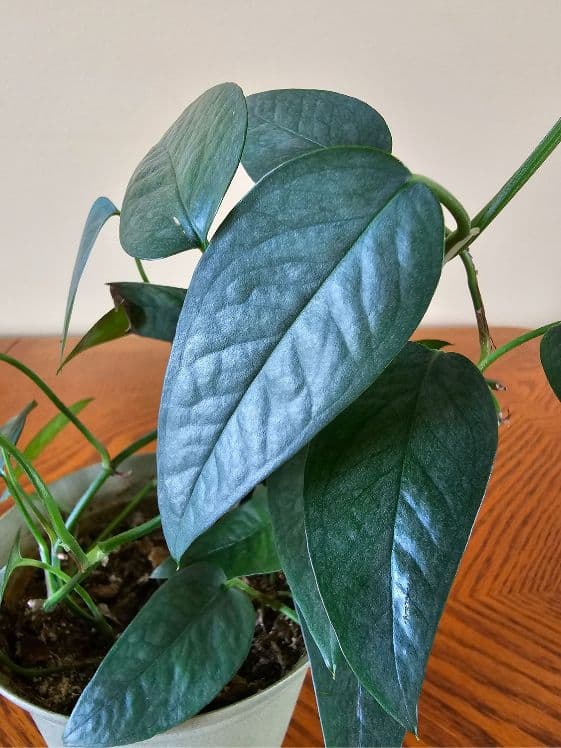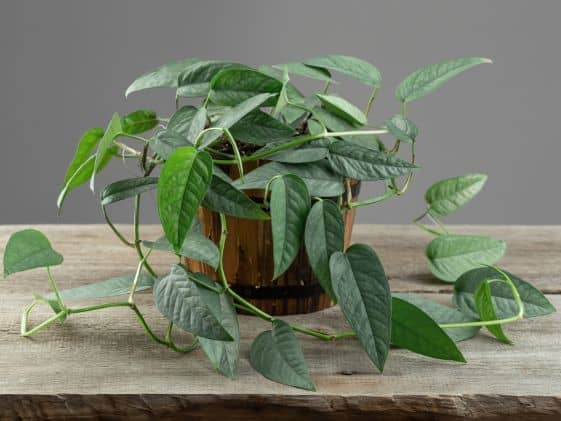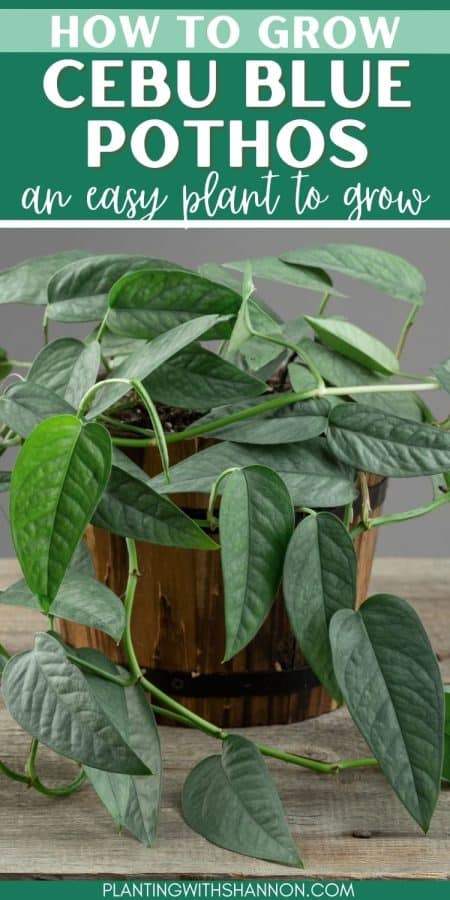Cebu Blue Pothos is an eye-catching tropical plant known for its stunning blue-green foliage.
Not only does it add a pop of color to your indoor space, but it’s also easy to grow and care for, making it an ideal choice for both beginner and experienced plant enthusiasts.
With proper attention to lighting, watering, and soil conditions, you can watch your Cebu Blue thrive and flourish.
This post may contain affiliate links. That means if you click on them and buy something, I may receive a small commission. Read my Disclaimer Policy to learn more. As an Amazon Associate, I earn from qualifying purchases.

What is a Cebu Blue Pothos?
The Cebu Blue Pothos (Epipremnum pinnatum ‘Cebu Blue’) is named after its native home, the island of Cebu in the Philippines and belongs to the Araceae family.
This cultivar of Epipremnum pinnatum is admired for its steel-blue foliage that can also have hues of green, blue, or silvery colors.
The leaves are long and thin unlike the Epipremnum aureum varieties, like the golden pothos, which have rounded, heart-shaped leaves.
Are Cebu Blue Poisonous/Toxic?

Yes, Cebu Blue is toxic to cats, dogs, and humans.
This is because it’s part of the Epipremnum genus, which contains calcium oxalate crystals.
When ingested, calcium oxalate crystals can cause irritation to your pet’s mouth and gastrointestinal tract, leading to drooling, vomiting, and difficulty swallowing.
It’s essential to keep your Cebu Blue out of reach of your pets to prevent accidental ingestion.
You might consider placing it in an area that your pets cannot access, such as high shelves, hanging baskets, or a room that is off-limits to your furry friends.
While it is toxic/poisonous to humans to consume, it is generally safe to handle and care for this plant.
Just be sure to wash your hands thoroughly after touching the plant, especially if you have sensitive skin or are prone to skin irritations.
Cebu Blue Pothos Care

The Cebu Blue is low-maintenance and easy to care for, making it an excellent choice for both beginners and experienced growers.
Lighting
To ensure your Cebu Blue thrives, it requires bright, indirect light.
Although it can tolerate low light conditions, the foliage’s vibrant colors may become less prominent and it may become leggy.
It will also be more difficult for the Cebu Blue to develop fenestrations if the lighting is not bright enough.
Avoid direct sunlight, as it can burn the leaves.
Watering
Cebu Blue can be forgiving when it comes to watering.
Water your plant thoroughly, allowing excess water to escape the drainage holes.
Let the top inch or two of soil dry out before watering again.
Overwatering can lead to root rot, so it is important to make sure you let the top inch or so of soil dry out before watering again.
Humidity
Being a tropical plant, Cebu Blue enjoys higher humidity levels.
However, it can adapt to various conditions and thrive in typical indoor humidity levels.
For those with low humidity levels in their home, you can try increasing the humidity around the Cebu Blue plant by using a pebble tray or by grouping several plants close to each other.
Temperature
Cebu Blue prefers consistent temperatures between 65-85°F (18-29°C).
Keep it away from cold drafts, like a drafty window in the winter as this can negatively impact its growth.
Soil
A well-draining soil mixture is essential for your Cebu Blue.
I like to use a combination of potting soil and orchid bark, though you could also use perlite, to ensure proper drainage.
Fertilizing
Fertilize your Cebu Blue every 4-6 weeks during the growing season, using a balanced liquid fertilizer.
Make sure to follow the directions on the specific fertilizer that you are using for the frequency and amount to use.
Pruning Your Cebu Blue
You can prune your Cebu Blue to encourage bushier growth and to keep the vines from getting too long.
When pruning use clean, sharp pruning shears or scissors.
Remove any damaged or dead leaves and stems as well as any leaves that appear to be yellow or browning.
Repotting Frequency
Repot your Cebu Blue when it becomes root-bound, typically every 1-2 years.
Choose a container that is only slightly larger than the current one, as this pothos prefers being snug in its pot.
Using a well-draining soil, gently loosen the root ball, and place it in the new pot, filling in the remaining space with fresh soil.
Propagating a Cebu Blue
Propagating a Cebu Blue is relatively easy to do.
My preferred method of propagating is by water propagation.
To start you’ll need some healthy stem cuttings.
Choose stem tips with at least 2 nodes that look vibrant and strong.
You also want to have at least one leaf on the stem cutting you want to propagate.
Once you have your cuttings, remove the bottom leaf from each stem.
If you have only a single node cutting, leave the leaf on the stem.
Then place your cutting in a clean jar and fill it with enough water to cover the bottom node but not reach the next node.
Place the jar with the cuttings in a warm location with bright indirect light.
Once the cuttings have grown roots that are at least an inch or two long, they can be potted up with well draining potting soil.
Growth Stages of a Cebu Blue
The Cebu Blue has two distinct growth stages: juvenile and mature.
The juvenile phase is the most commonly sold stage, especially in big box stores.

Some nurseries will carry the mature phase, but they are much more expensive. And much larger of a plant.
The juvenile stage of the Cebu Blue’s growth is distinct in that the leaves are small, elongated ovals.
The leaves of Cebu Blue in the mature phase are much larger and develop fenestrations.

Fenestrations are the cutouts that naturally form when the plant is mature.
The care of a Cebu Blue remains mostly the same regardless of what stage the plant is in.
The only difference is that a mature Cebu Blue needs something to climb, like a moss pole.
A juvenile Cebu Blue can grow with or without anything to climb.
Common problems with a Cebu Blue
Like all houseplants, the Cebu Blue is susceptible to various issues.
Brown tips
Brown tips on your Cebu Blue’s leaves could be an indication of improper watering.
Ensure you’re allowing the top 1 to 2 inches of soil to dry between waterings.
Then water thoroughly, allowing the excess water to drain from the bottom of the pot.
Your plant may also be sensitive to the chemicals found in tap water, so you might want to consider using filtered water or rainwater to avoid this issue.
Leggy growth
If your Cebu Blue is experiencing leggy growth, it may be due to insufficient light exposure.
This plant thrives in bright, indirect light, so make sure you’re providing an ideal environment.
To promote bushier growth, you can:
- Move your plant to a brighter location
- Rotate the pot periodically to ensure even light exposure
- Prune long, leggy stems to encourage new growth
Drooping Leaves
Drooping leaves are often a sign of underwatering, though they can also be a sign of overwatering.
To fix the issue, start by checking if the soil is dry.
If dry, water the plant and the leaves should perk back up within a few hours to a day.
Then increase how often you water by a few days to prevent the issue from happening again.
But before you water, make sure the top inch is dry to prevent overwatering.
Common Pests
Cebu Blue plants can occasionally fall victim to pests, but with proper care and vigilance, you can protect your plant from these unwanted invaders.
The most common pests affecting Cebu Blue plants are mealybugs, spider mites, and fungus gnats.
Mealybugs
Mealybugs are small, soft-bodied insects that are typically covered with a cottony, white material.
They tend to cluster on the plant’s leaves or stems, and can weaken your Cebu Blue by sucking its sap.
To keep your plant safe from these pests, inspect your Cebu Blue regularly for signs of infestation.
If you spot mealybugs, you can use rubbing alcohol to remove individual bugs.
Then a systemic can be used to help treat any mealybugs you missed.
Spider mites
Spider mites are another common pest that may injure your Cebu Blue.
These tiny creatures create very fine webbing on the foliage, which may cause leaves to turn yellow or curl up.
You can use organic treatments, such as neem oil, to remove spider mites.
Regularly inspecting your plant and keeping its environment and humidity levels optimal can help prevent these pests from infesting your Cebu Blue.
Fungus Gnats
Fungus gnats are tiny black flies that are annoying but seldom damage a plant.
Their larvae feed on organic matter in the soil and can, in large quantities, feed on the roots and damage the plant.
The easiest treatment for fungus gnats is to simply add a yellow sticky trap to the pot.
The adults are attracted to the yellow sticky traps and get stuck preventing them from laying more eggs.
Sticky traps may not eliminate the problem completely, but they do keep the population small enough that it won’t harm your plants.
Frequently Asked Questions
Are Cebu Blue Pothos rare?
Cebu Blue Pothos are considered a somewhat rare plant among houseplant enthusiasts, especially compared to the more common Golden Pothos.
However as more big box stores get Cebu Blue plants in, their rarity decreases.
Is Cebu Blue a true pothos?
Cebu Blue is a cultivar of the species Epipremnum pinnatum, which is a close relative of the pothos which is an Epipremnum aureum.
Although it shares similar characteristics with these other pothos varieties, its blue-green foliage makes it distinct and quite special.
Does Cebu Blue have fenestrations?
Yes, Cebu Blue Pothos plants can develop fenestrations – which are natural gaps or openings in the leaves – as they mature.
However, these openings may not be present in younger plants or when the plant is grown in less than ideal conditions.
How can I encourage fenestrations in Cebu Blue?
To encourage fenestrations in your Cebu Blue Pothos, provide it with ample bright indirect light, consistent watering, and proper nutrients.
Climbing or trailing support, such as a moss pole, can also stimulate the plant to produce larger leaves with fenestrations.
How long does it take to get fenestrations?
The time it takes for a Cebu Blue Pothos to develop fenestrations can vary depending on several factors, including the plant’s age, environment, and overall care.
In general, it may take at least a few years of growth under optimal conditions for fenestrations to appear.
Patience and consistent care are key to helping your Cebu Blue Pothos reach its full potential.





